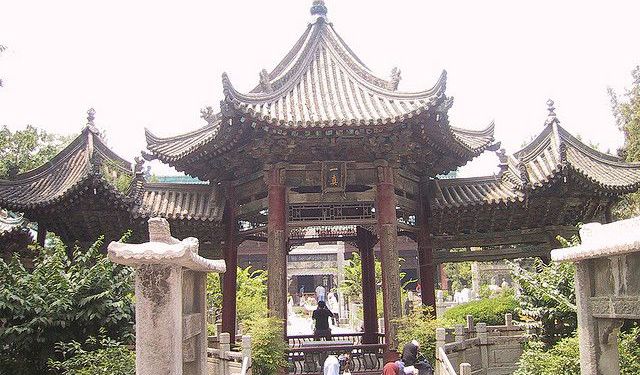
The Terracotta Warriors Museum, Xian (must see)
The Terracotta Warriors Museum is a unique onsite museum with objects uncovered during archeological excavations in 1974. The lifelike terracotta figures were buried near the tomb of Emperor Qin Shi Huang the first emperor of China.
Farmers from the Jiangzhai Xichang village, attempting to dig a well, accidentally discovered the ancient terracotta army. The Chinese Cultural Relics Administrative Department sent a team of archeologists to scientifically excavate this phenomenal relic from China’s past. Three large pits of terracotta figures were found covering an area 20,000 square meters. The pits are located near the mound of the tomb of Emperor Qin Shi Huang and the army was created to protect him in his afterlife. A steel hangar like structure was built over the pits to protect it from damage and the museum was officially inaugurated in 1979.
The terracotta statues are of different heights according to their stature. The taller statues are of generals and the other figures are of soldiers and charioteers. The pits have figures of 8000 soldiers, 130 chariots, 520 horses and 150 cavalry horses. In addition to the army, there are figures of court officials, acrobats and musicians. Other objects discovered during the excavations including weaponry used by the Qin Dynasty warriors are also displayed.
Farmers from the Jiangzhai Xichang village, attempting to dig a well, accidentally discovered the ancient terracotta army. The Chinese Cultural Relics Administrative Department sent a team of archeologists to scientifically excavate this phenomenal relic from China’s past. Three large pits of terracotta figures were found covering an area 20,000 square meters. The pits are located near the mound of the tomb of Emperor Qin Shi Huang and the army was created to protect him in his afterlife. A steel hangar like structure was built over the pits to protect it from damage and the museum was officially inaugurated in 1979.
The terracotta statues are of different heights according to their stature. The taller statues are of generals and the other figures are of soldiers and charioteers. The pits have figures of 8000 soldiers, 130 chariots, 520 horses and 150 cavalry horses. In addition to the army, there are figures of court officials, acrobats and musicians. Other objects discovered during the excavations including weaponry used by the Qin Dynasty warriors are also displayed.
Want to visit this sight? Check out these Self-Guided Walking Tours in Xian. Alternatively, you can download the mobile app "GPSmyCity: Walks in 1K+ Cities" from Apple App Store or Google Play Store. The app turns your mobile device to a personal tour guide and it works offline, so no data plan is needed when traveling abroad.
The Terracotta Warriors Museum on Map






Sight Name: The Terracotta Warriors Museum
Sight Location: Xian, China (See walking tours in Xian)
Sight Type: Museum/Gallery
Sight Location: Xian, China (See walking tours in Xian)
Sight Type: Museum/Gallery
Walking Tours in Xian, China
Create Your Own Walk in Xian
Creating your own self-guided walk in Xian is easy and fun. Choose the city attractions that you want to see and a walk route map will be created just for you. You can even set your hotel as the start point of the walk.
Xian Introduction Walking Tour
Xian became a cultural and political center of China in the 11th century BC and was the capital city of eleven imperial Chinese dynasties.
For a western comparison, Xian closely resembles Rome. At the beginning of the first millennium, there were two major powers sitting at the ends of the civilized world, the Roman Empire in the west and the Han Dynasty in the east, each commanding roughly the... view more
Tour Duration: 2 Hour(s)
Travel Distance: 4.4 Km or 2.7 Miles
For a western comparison, Xian closely resembles Rome. At the beginning of the first millennium, there were two major powers sitting at the ends of the civilized world, the Roman Empire in the west and the Han Dynasty in the east, each commanding roughly the... view more
Tour Duration: 2 Hour(s)
Travel Distance: 4.4 Km or 2.7 Miles
Historical Religious Sites
A melting pot of different cultures and faiths, Xian, once the start of the historical Silk Road, for centuries had seen traders from far and wide come to do business. Many a foreigner eventually settled in Xian, bringing along their cuisine, customs, and religious practices. Hence the number of pagodas, Buddhist and Taoist temples, as well as mosques found in the city, some of which trace back... view more
Tour Duration: 1 Hour(s)
Travel Distance: 2.9 Km or 1.8 Miles
Tour Duration: 1 Hour(s)
Travel Distance: 2.9 Km or 1.8 Miles
Shopping Streets Tour
Back in the day, Xian was the starting point of the ancient Silk Road. Foreign traders used to come here to procure local merchandise such as tea, silk, and porcelain that were in high demand internationally throughout centuries.
In recent years, although the commercial center in China has shifted to the coastline area, Xian remains a major destination for quality shopping, especially when it... view more
Tour Duration: 1 Hour(s)
Travel Distance: 2.0 Km or 1.2 Miles
In recent years, although the commercial center in China has shifted to the coastline area, Xian remains a major destination for quality shopping, especially when it... view more
Tour Duration: 1 Hour(s)
Travel Distance: 2.0 Km or 1.2 Miles



